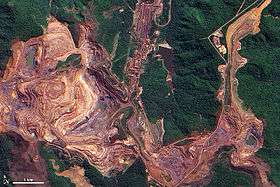Mining in Brazil
Mining in Brazil is centered on the extraction of gold, copper, tin, iron and bauxite.
History
- Discovery of first gold rush in 1690s, gold discoveries made in streams not far from present day city of Belo Horizonte.
- In 1729 diamonds were discovered in the same area. This started a diamond rush.
- By 1760 nearly half of the world's gold was from Brazil.
- In the early 18th century nearly 400,000 Portuguese immigrants came to mine in southern Brazil.
- Over half a million African slaves were shipped to work in the gold mines.
- The Gongo Soco gold mine, operated by the Imperial Brazilian Mining Association of Cornwall using skilled Cornish miners and unskilled slaves, produced over 12,000 kilograms (26,000 lb) of gold between 1826 and 1856.[1]
Mining today
In 1988 Brazil was the 5th largest gold producer in the world. Brazil mined iron, gold, tin, copper and Bauxite (contains aluminium).
Environmental Impact

The mining activity has caused severe environmental impact in Brazil area. Among the different types of environmental degradation, mining activities has caused landscape degradation, erosion, soil contamination, groundwater and surface water pollution.
The Bento Rodrigues dam disaster is considered to be worse environmental incident in the history of mining in Brazil.[2] On November 5, 2015, two iron ore tailings dams of Samarco ( a joint-venture between Vale S.A. and BHP Billiton) collapsed. [3] The mud containing by-products of mining flowed down, destroying completely Bento Rodrigues, a sub-district of Mariana, and invaded other neighbouring cities, such as Barra Longa, causing at least six casualties, and destroying at least 200 homes. The mud reached the Rio Doce, contaminated the water, and compromised the water supply of cities in Minas Gerais and Espírito Santo that lay by the river. Several species of fish died to the low oxygen levels in the water, and up till today scientists could not estimate the total environmental impact.
See also
References
- ↑ Conjunto de ruínas do Gongo Soco (in Portuguese), IEPHA: Instituto Estadual do Patrimônio Histórico e Artístico de Minas Gerais, retrieved 2016-08-12
- ↑ "Rompimento de barragens causa "maior dano ambiental da história de Minas", diz promotor" [The collapse of the Samaco's dams has caused the "largest environmental disaster in the history of Minas Gerais", says public prosecutor] (in Portuguese). Record. 2015-11-05. Retrieved 2015-11-11.
- ↑ Shasta Darlington (2015-11-07). "Dam break sweeps away homes in Brazil, killing at least 1 person". CNN. Retrieved 2015-11-11.